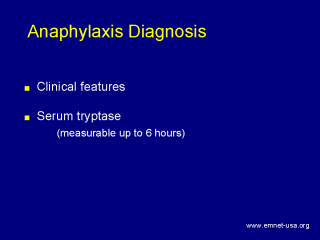 |
The diagnosis of
anaphylaxis is made in the clinical setting on the basis of clinical
presentation. Cutaneous and respiratory findings occur in at least 60% of
subjects described in 7 retrospective series encompassing 1217 subjects.
Urticaria and angioedema are the most common manifestations and the absence
of either should prompt a physician to consider another diagnosis, except
perhaps where food-induced anaphylaxis is suspected. The diagnosis can be
confirmed in doubtful cases by the demonstration of the presence of elevated
plasma concentrations of the mast cell enzyme, tryptase, which is specific
for mast cell degranulation. Tryptase remains elevated for up to six hours
following anaphylaxis, is stable while refrigerated, and may be assayed in
serum previously obtained for other purposes. Although serum tryptase may
not be elevated in food-related anaphylaxis. |
